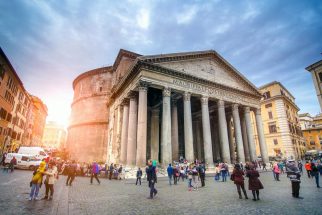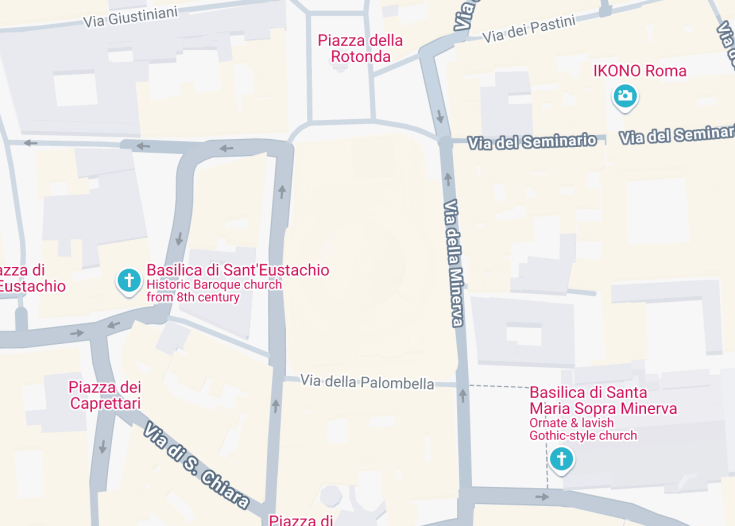The Pantheon, nestled in the heart of Rome, Italy, stands as a monument of ancient architecture and enduring beauty. Originally built as a temple to all gods by Marcus Agrippa and later rebuilt by Emperor Hadrian, it is remarkably well-preserved. Its grand dome, with the famous oculus, remains the largest unreinforced concrete dome in the world. Today, it functions as a church and a popular tourist site, attracting millions who wish to gaze upon its architectural splendor and its historic significance.
To make the most of your visit, aim to arrive early to avoid the crowds and fully appreciate the Pantheon’s architectural details and solemn atmosphere.
Consider visiting on a rainy day to experience the captivating sight of rain falling through the oculus, a truly unique spectacle within this ancient edifice.
Pantheon: A Marvel of Ancient Roman Architecture
The Pantheon in Rome, Italy, is one of the most well-preserved monuments from ancient Rome and serves as a testament to the architectural brilliance of the time. Originally built as a temple to the gods, the Pantheon has stood for nearly 2,000 years and continues to captivate visitors with its stunning design. This architectural marvel features a magnificent dome, which is still the world’s largest unsupported concrete dome. The oculus at its center allows natural light to flood the interior, creating a remarkable atmosphere that enchants tourists. Inside, visitors can admire the harmonious proportions and the intricate marble floor, which reflect the ingenuity of Roman engineering. The building’s enduring legacy also includes its conversion into a Christian church in the 7th century, which has helped preserve its structure over centuries. Today, the Pantheon attracts millions of tourists each year, drawing them in with its storied history and breathtaking architecture, making it a must-visit destination when exploring the Eternal City.
Top Attractions at the Pantheon in Rome
When visiting the Pantheon, there are several attractions and activities that shouldn’t be missed.
Explore the Dome
The most striking feature of the temple is its dome, which offers an awe-inspiring view of the heavens.
Admire the Interior
The interior showcases beautiful chapels and tombs of notable figures, including the famous artist Raphael.
Attend Mass
As an active church, the Pantheon holds regular services, offering a unique opportunity for visitors to experience its spiritual ambiance. No matter how you choose to enjoy it, the Pantheon is sure to leave an unforgettable impression.
The Pantheon’s Oculus
The oculus of the Pantheon, a circular opening at the apex of the dome, has a diameter of 8.2 meters (27 feet). This fascinating feature is the only source of natural light within the temple. As rain enters through the oculus, visitors often notice that the interior drains effectively due to the slight slope of the floor. This clever design not only showcases the engineering prowess of ancient Romans but also creates a mesmerizing effect as sunlight streams in throughout the day, illuminating the temple’s interior in dynamic ways. The oculus is indeed a symbol of the connection between the earthly realm and the divine.
Discover the Marvels of the Pantheon in Rome, Italy
The Pantheon, an architectural wonder, stands as a testament to the ingenuity of ancient Rome. Originally built as a temple for the Roman gods, this magnificent structure has captivated visitors for centuries with its immense dome and breathtaking oculus. As you approach the Pantheon, you are greeted by its impressive portico of Corinthian columns, a sight that truly prepares you for the awe waiting within.
This majestic site is suitable for all ages; history buffs, architecture enthusiasts, and casual travelers alike will find something to enthrall them. Visitors can expect to be mesmerized by the vastness of the interior space and the harmonious proportions that make the Pantheon a treasure of engineering. The hauntingly beautiful light that filters through the oculus creates a celestial atmosphere, illuminating the intricate marble floors and the tombs of famous figures like Raphael.
When planning your visit, consider incorporating the Pantheon into a broader itinerary that includes other significant highlights of Rome. It’s located within walking distance of the lively Piazza Navona and the historic Trevi Fountain, making it an ideal stop on your exploration of the Eternal City. As you wander through Rome’s winding streets, you will encounter charming cafés and shops, perfect for sampling local treats or finding a souvenir.
For a truly enriching experience, consider joining a guided tour that provides insights into the history and symbolism of the Pantheon. A professional guide can delve into its origins, its conversion into a church, and its continued significance in modern Rome. A visit during quieter hours, such as early morning or late afternoon, is advisable for those who prefer a more serene atmosphere.
When is the Best Time to Visit the Pantheon in Rome, Italy?
The Pantheon can be visited year-round; however, the most enjoyable times are during the spring (April to June) and fall (September to October). During these months, the weather is pleasant, and crowds are more manageable compared to the peak summer season. Early mornings or late afternoons also offer fewer tourists and more tranquil experiences within this historic site.
Recurring Events
On special religious occasions, such as Easter and the Feast of the Assumption, the Pantheon holds unique ceremonies. Attending services during these events can provide visitors with a deeper insight into the spiritual significance of this iconic monument.
Accessibility and Limitations
The Pantheon is accessible to most visitors, including those with mobility challenges, but it’s essential to be aware of certain limitations. There can be uneven surfaces and crowds that may pose challenges.
Accessibility
Limitations
- Visitors are advised to maintain a respectful demeanor, particularly during services.
- Photography is permitted, but flash photography and tripods are not allowed.
- Food and drink are prohibited inside the Pantheon.
Notes to visitors
- Be mindful of dress codes; modest clothing is recommended.
- Expect potential wait times, especially during peak tourist seasons.
- Visit on weekdays for a quieter experience.
General Information
Details for your visit to the Pantheon
Location
The Pantheon is conveniently located in the heart of Rome, surrounded by charming cobblestone streets and lively piazzas. It is a short stroll away from other famous landmarks, making it easy to include in your explorations of the city.
Address:
Piazza della Rotonda, 00186 Roma RM, ItalyVisiting Information
The Pantheon is open to visitors daily, with no strict closing hours. It is recommended to visit in the early morning to experience the building in peace, free from large crowds. The late afternoon light through the oculus offers a stunning ambiance as well.
How to Reach the Pantheon
The Pantheon can be reached easily from various points in Rome. Here are a couple of commonly used modes of transport:
Car
The Pantheon is accessible by car, although parking is limited in the surrounding area. It’s advisable to utilize public transportation where possible.
| Route | Distance | Travel time |
|---|---|---|
| From Termini Station | 2 kilometers (1.2 miles) | 10 minutes |
| From Vatican City | 3 kilometers (1.9 miles) | 15 minutes |
| From Colosseum | 2 kilometers (1.2 miles) | 15 minutes |
Bus
Utilizing public transportation is highly recommended. Several buses will drop you off a short walk from the Pantheon.
| Bus Line | Distance | Travel time |
|---|---|---|
| Bus 30 | 500 meters (0.3 miles) | 5 minutes |
| Bus 81 | 1 kilometer (0.6 miles) | 10 minutes |
| Bus 64 | 800 meters (0.5 miles) | 8 minutes |
Public Transit
Public buses and trams offer convenient stops near the Pantheon, making it easily accessible from most parts of the city.
Metro: Take the Metro line A to Spagna or Barberini (click to see our guide to the Metro).
Taxi: This is an effective but rather costly way to get around Rome (click to see our guide to taxis in Rome).
Limo service (NCC): A rental service with driver offered by ArcheoRoma.
Nearby Attractions
Explore these nearby marvels when visiting the Pantheon:
- Piazza Navona – 350 meters (0.2 miles)
- Trevi Fountain – 800 meters (0.5 miles)
- Piazza Venezia – 900 meters (0.6 miles)
- Palazzo Montecitorio – 1 kilometer (0.6 miles)
- Santa Maria Sopra Minerva – 1 kilometer (0.6 miles)
- San Lorenzo in Lucina – 1.1 kilometers (0.7 miles)
- Altar of the Fatherland – 1.2 kilometers (0.8 miles)
- Church of San Luigi dei Francesi – 1.2 kilometers (0.8 miles)
- Castel Sant’Angelo – 1.5 kilometers (0.9 miles)
- Vatican Museums – 2 kilometers (1.2 miles)
- Colosseum – 2 kilometers (1.2 miles)
- Spanish Steps – 1.5 kilometers (0.9 miles)
Common questions
What is the architectural significance of the Pantheon in Rome?
What are some interesting facts about the Pantheon?
Why is the Pantheon considered one of the best-preserved ancient structures?
What should visitors know about the interiors of the Pantheon?
What are the key historical events associated with the Pantheon?

Is the Pantheon in Rome, Italy worth visiting?
The Pantheon in Rome is undeniably a top attraction that deserves a spot on any travel itinerary. This ancient temple, dedicated to the gods of Ancient Rome, boasts an impressive dome that remains the largest unreinforced concrete dome in the world. As you step inside, the grandeur and intricate details of its architecture leave a lasting impression. Beyond its architectural beauty, the Pantheon serves as a testament to Rome’s rich history, showcasing the brilliance of ancient engineering. The interplay of light and space inside the dome creates a serene atmosphere, inviting visitors to ponder its significance. Moreover, its central location makes it accessible, allowing tourists to explore nearby attractions. For those who appreciate history and beauty, the Pantheon is an unforgettable experience.










